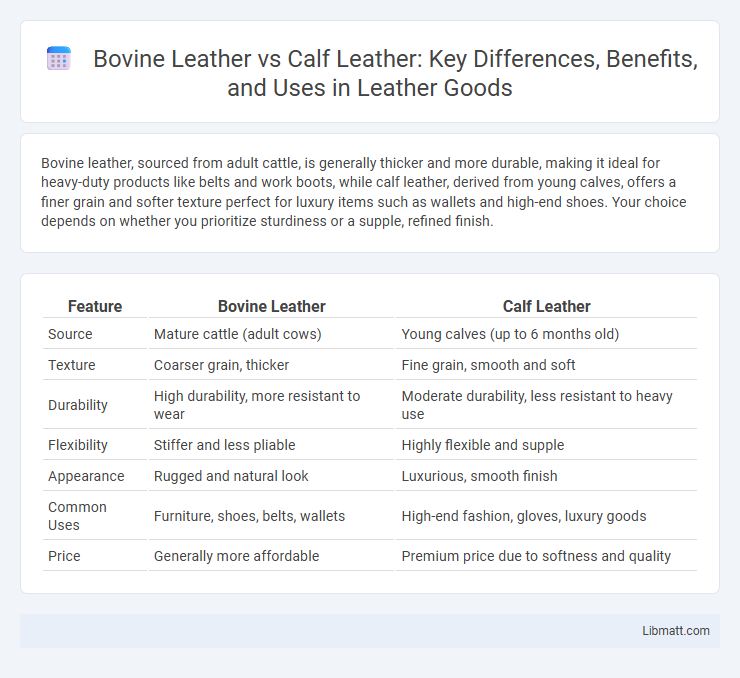Bovine leather, sourced from adult cattle, is generally thicker and more durable, making it ideal for heavy-duty products like belts and work boots, while calf leather, derived from young calves, offers a finer grain and softer texture perfect for luxury items such as wallets and high-end shoes. Your choice depends on whether you prioritize sturdiness or a supple, refined finish.
Table of Comparison
| Feature | Bovine Leather | Calf Leather |
|---|---|---|
| Source | Mature cattle (adult cows) | Young calves (up to 6 months old) |
| Texture | Coarser grain, thicker | Fine grain, smooth and soft |
| Durability | High durability, more resistant to wear | Moderate durability, less resistant to heavy use |
| Flexibility | Stiffer and less pliable | Highly flexible and supple |
| Appearance | Rugged and natural look | Luxurious, smooth finish |
| Common Uses | Furniture, shoes, belts, wallets | High-end fashion, gloves, luxury goods |
| Price | Generally more affordable | Premium price due to softness and quality |
Introduction to Bovine and Calf Leather
Bovine leather is derived from adult cattle and is characterized by its durability, strength, and coarse texture, making it ideal for heavy-duty applications such as saddles and work boots. Calf leather comes from young calves, offering a finer grain, softer touch, and more luxurious appearance, frequently used in high-end fashion, gloves, and premium upholstery. The distinction in fiber density and thickness between bovine and calf leather affects their flexibility, lifespan, and suitability for various leather goods.
Source and Age of the Animal
Bovine leather is derived from mature cattle, typically older than one year, providing a thicker and more durable material ideal for heavy-duty products. Calf leather, sourced from younger calves usually under six months old, offers a finer grain, softer texture, and more supple feel, making it highly prized for luxury goods. Understanding the source and age of the animal helps you select leather suited to the desired quality and application.
Texture and Grain Differences
Bovine leather features a coarser texture with visible grain patterns, offering durability and a rugged appearance ideal for heavy use. Calf leather, in contrast, exhibits a finer, smoother texture with tighter grain, providing a softer and more luxurious feel suited for high-end products. Understanding these texture and grain differences helps you select the best leather based on your preference for durability or elegance.
Durability and Strength Comparison
Bovine leather, derived from mature cattle hides, offers superior durability and strength due to its thicker fibers and higher density, making it ideal for heavy-use items like furniture and work boots. Calf leather, sourced from young calves, is finer and smoother with a softer texture but generally less durable under extreme wear and tear compared to bovine leather. Your choice depends on whether you prioritize robust longevity or a more delicate, refined finish for items like luxury gloves or handbags.
Softness and Flexibility
Calf leather is renowned for its exceptional softness and flexibility due to the young age of the animal, resulting in a finer grain and smoother texture. Bovine leather, derived from mature cattle, tends to be thicker and more durable but less pliable compared to calf leather. Your choice depends on whether you prioritize the luxurious feel and supple nature of calf leather or the robustness and strength of bovine leather.
Appearance and Aesthetic Qualities
Bovine leather exhibits a coarser grain and more pronounced texture, giving it a rugged and durable appearance ideal for casual and heavy-use items. Calf leather offers a finer, smoother surface with a subtle sheen, highlighting its softness and luxury, commonly preferred for high-end fashion and accessories. The natural markings on bovine leather are larger and more varied, while calf leather features minimal imperfections, contributing to its uniform and refined aesthetic.
Common Uses in Fashion and Industry
Bovine leather, known for its durability and thicker texture, is commonly used in heavy-duty fashion items such as belts, boots, and jackets, as well as industrial products like upholstery and saddlery. Calf leather, prized for its softness, fine grain, and smooth finish, is preferred in high-end fashion for luxury handbags, gloves, wallets, and premium footwear. Both types of leather cater to distinct market needs, with bovine leather providing robust wear resistance and calf leather offering refined aesthetics and comfort.
Cost and Price Considerations
Bovine leather generally has a lower cost compared to calf leather due to the larger supply and less intricate processing requirements. Calf leather commands a higher price because of its finer grain, softness, and limited availability from younger animals. Buyers should consider that calf leather's premium price reflects its superior quality, making it ideal for luxury goods despite its higher cost.
Maintenance and Care Requirements
Bovine leather requires regular conditioning to prevent dryness and cracking due to its thicker grain and durability, making it suitable for heavy use but needing consistent upkeep. Calf leather, being finer and more delicate, demands gentler cleaning methods and the use of specialized leather conditioners to maintain its softness and prevent damage. Both types benefit from avoiding prolonged exposure to water and direct sunlight to preserve their texture and appearance.
Sustainability and Ethical Aspects
Bovine leather, sourced from adult cattle, often involves larger environmental footprints due to extensive water usage and more significant methane emissions linked to mature livestock farming. Calf leather, derived from younger animals, typically requires fewer resources but raises ethical concerns related to animal welfare and the morality of using young calves for luxury goods. Your choice between bovine and calf leather impacts both sustainability and ethics, with bovine leather tending towards greater ecological strain while calf leather highlights concerns about animal rights.
Bovine leather vs calf leather Infographic

 libmatt.com
libmatt.com